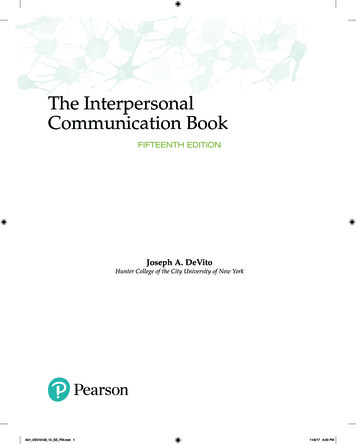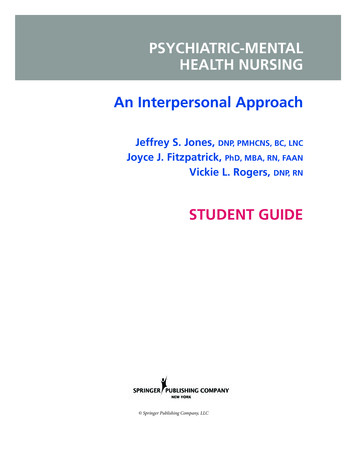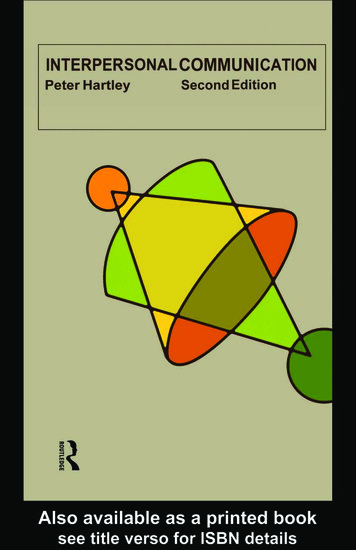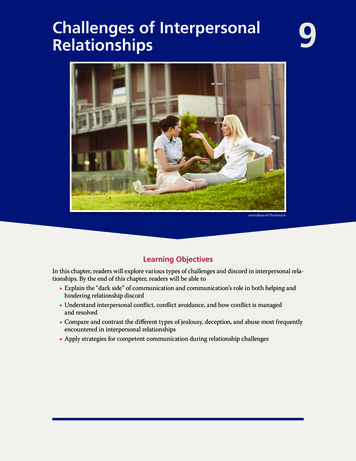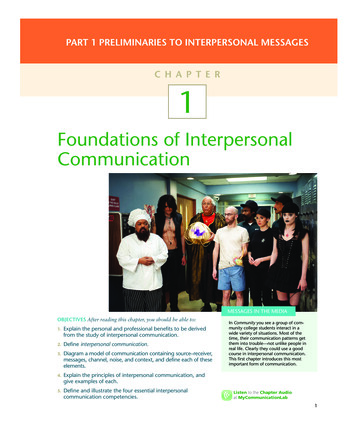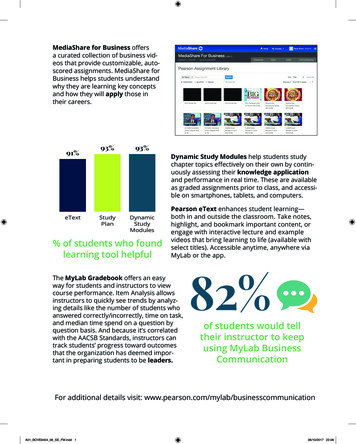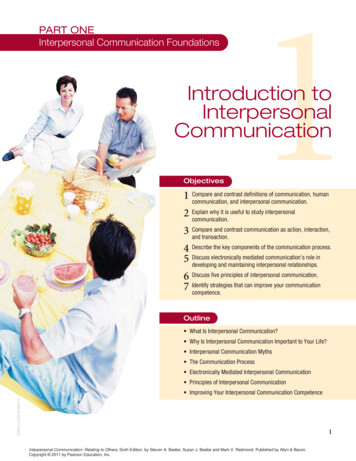
Transcription
PART ONEInterpersonal Communication Foundations1Introduction toInterpersonalCommunicationObjectivesand contrast definitions of communication, human1 Comparecommunication, and interpersonal communication.why it is useful to study interpersonal2 Explaincommunication.and contrast communication as action, interaction,3 Compareand transaction.4 Describe the key components of the communication process.electronically mediated communication’s role in5 Discussdeveloping and maintaining interpersonal relationships.6 Discuss five principles of interpersonal communication.strategies that can improve your communication7 Identifycompetence.Outline What Is Interpersonal Communication? Why Is Interpersonal Communication Important to Your Life? Interpersonal Communication Myths The Communication Process Electronically Mediated Interpersonal Communication Principles of Interpersonal CommunicationISBN 0-558-82929-5 Improving Your Interpersonal Communication Competence1Interpersonal Communication: Relating to Others, Sixth Edition, by Steven A. Beebe, Susan J. Beebe and Mark V. Redmond. Published by Allyn & Bacon.Copyright 2011 by Pearson Education, Inc.
2Part OneInterpersonal Communication FoundationsVirginia SatirInterpersonal communication is like breathing; it is arequirement for life. And, like breathing, interpersonalcommunication is inescapable. Unless you live in isolation,you communicate interpersonally every day. Listening to yourroommate, talking to a teacher, meeting for lunch with afriend, and talking to your parents or your spouse are allexamples of interpersonal communication.It is impossible not to communicate with others.1 Evenbefore we are born, we respond to movement and sound.With our first cry, we announce to others that we are here. Once we make contactwith others, we communicate, and we continue to do so until we draw our last breath.Even though many of our messages are not verbalized, we nonetheless send messagesto others—intentionally and sometimes unintentionally. Whatever our intentions,people draw conclusions from our behavior. Without interpersonal communication,a special form of human communication that occurs as we manage our relationships,people suffer and even die. Recluses, hermits, and people isolated in solitary confinement dream and hallucinate about talking with others face to face.Human communication is at the core of our existence. Think of the number oftimes you communicated with someone today, as you worked, ate, studied, shopped,or went about your other daily activities. Most people spend between 80 and 90 percent of their waking hours communicating with others.2 It is through these interactions with others that we develop interpersonal relationships.3Because these relationships are so important to our lives, later chapters will focuson the communication skills and principles that explain and predict how we develop,sustain, and sometimes end relationships. We’ll explore such questions as the following: Why do we like some people and not others? How can we interpret other people’sunspoken messages with greater accuracy? Why do some relationships blossom andothers deteriorate? How can we better manage disagreements with others? How canwe better understand our relationships with our family, friends, and coworkers?This chapter charts the course ahead, addressing key questions about what interpersonal communication is and why it is important. We will begin by seeing how ourunderstanding of the interpersonal communication process has evolved. And we willconclude by examining how we initiate and sustain relationships through interpersonal communication.Communication is to arelationship what breathingis to maintaining life.What Is InterpersonalCommunication?communication Process ofacting on information.Interpersonal Communication: Relating to Others, Sixth Edition, by Steven A. Beebe, Susan J. Beebe and Mark V. Redmond. Published by Allyn & Bacon.Copyright 2011 by Pearson Education, Inc.ISBN 0-558-82929-5human communication Processof making sense out of the worldand sharing that sense with othersby creating meaning through theuse of verbal and nonverbalmessages.To understand interpersonal communication, we must begin by understanding how itrelates to two broader categories: communication in general and human communication. Scholars have attempted to arrive at a general definition of communication fordecades, yet experts cannot agree on a single one. One research team counted morethan 126 published definitions.4 In the broadest sense, communication is the processof acting on information.5 Someone does or says something, and others think or dosomething in response to the action or the words as they understand them.To refine our broad definition, we can say that human communication is theprocess of making sense out of the world and sharing that sense with others by creating meaning through the use of verbal and nonverbal messages.6 We learn aboutthe world by listening, observing, tasting, touching, and smelling; then we share our
Chapter 1Introduction to Interpersonal Communication3conclusions with others. Human communication encompasses many media: speeches,e-mail, songs, radio and television broadcasts, online discussion groups, letters, books,articles, poems, and advertisements.Interpersonal communication is a distinctive, transactional form of human communication involving mutual influence, usually for the purpose of managing relationships. The three essential elements of this definition differentiate the unique nature ofinterpersonal communication from other forms of human communication.7ISBN 0-558-82929-5Interpersonal Communication Is a Distinctive Formof CommunicationFor years, many scholars defined interpersonal communication simply as communication that occurs when two people interact face to face. This limited definition suggests that if two people are interacting, then they are engaging in interpersonalcommunication. Today, interpersonal communication is defined not just by thenumber of people who communicate, but also by the quality of the communication.Interpersonal communication occurs not simply when you interact with someone,but when you treat the other person as a unique human being.8Think of all human communication as ranging on a continuum from impersonalto interpersonal communication. Impersonal communication occurs when you treatpeople as objects, or when you respond to their roles rather than to who they are asunique people. When you ask a server in a restaurant for a glass of water, you areinteracting with the role, not necessarily with the individual. You know nothing personal about this individual, and he or she knows nothing personal about you (unlessthis person eavesdrops on your conversation).Philosopher Martin Buber influenced our thinking about human communication when he presented the concept of honest dialogue as the essence of true, authentic communication.9 He described communication as consisting of two differentqualities of relationships. He discussed an “I–It” relationship as an impersonal one;the other person is viewed as an “It” rather than as an authentic, genuine person.When you buy a pair of socks at a clothing store, you have a two-person, face-to-face,relatively brief interaction with someone. You communicate. Yet that interchangecould hardly be described as intimate or personal.Interpersonal communication occurs when you interact with another person as aunique, authentic individual rather than as an object or an “It.” Buber calls this kindof relationship an “I–Thou” relationship. In this kind of relationship, there is truedialogue. An “I–Thou” relationship is not self-centered. The communicators havedeveloped an attitude toward each other that is honest, open, spontaneous, nonjudgmental, and based on equality rather than superiority.10We’re not suggesting that the goal of every communication transaction is todevelop a personal, intimate dialogue. That would be unrealistic and inappropriate.It’s possible to go through an entire day communicating with others but not beinvolved in interpersonal communication. As we noted earlier, interpersonal communication is a distinctive form of communication because it focuses on the uniquenessof others; it does not occur just because two people are communicating.Additionally, although interpersonal communication is more intimate andreveals more about the people involved than does impersonal communication, not allinterpersonal communication involves sharing closely guarded personal information.As we discuss later in the book, there are degrees of intimacy when interacting withothers.interpersonal communicationA distinctive, transactional form ofhuman communication involvingmutual influence, usually for thepurpose of managing relationships.impersonal communicationProcess that occurs when we treatothers as objects or respond totheir roles rather than to who theyare as unique persons.Interpersonal Communication: Relating to Others, Sixth Edition, by Steven A. Beebe, Susan J. Beebe and Mark V. Redmond. Published by Allyn & Bacon.Copyright 2011 by Pearson Education, Inc.
4Part OneInterpersonal Communication FoundationsThe Continuum Between Interpersonal Communication andRECAP Impersonal CommunicationInterpersonal CommunicationImpersonal Communication People are treated as unique individuals. People are treated as objects. People communicate in an “I–Thou” relationship.Each person is treated as special, and there is truedialogue and honest sharing of self with others. People communicate in an “I–It” relationship.Each person has a role to perform. Interpersonal communication often involvescommunicating with someone you care about,such as a good friend or cherished familymember. There is mechanical, stilted interaction, rather thanhonest sharing of feelings. Impersonal communication involves communicatingwith people such as sales clerks and servers—you haveno history with them, and you expect no future with them.Interpersonal Communication Involves MutualInfluence Between IndividualsEvery interpersonal communication transaction influences us. Mutual influence meansthat all partners in the communication are affected by a transaction. Interpersonal communication may or may not involve words. The degree of mutual influence varies agreat deal from transaction to transaction. You probably would not be affected a greatdeal by a brief smile that you received from a traveling companion on a bus, but youwould be greatly affected by your lover telling you he or she was leaving you. Sometimesinterpersonal communication changes our lives dramatically, sometimes in small ways.Long-lasting interpersonal relationships are sustained not by one person giving andanother taking, but by a spirit of mutual equality. Both you and your partner listen andrespond with respect for each other. There is no attempt to manipulate others.Buber’s concept of an “I–Thou” relationship includes the quality of being fully “present” when communicating with another person.11 To be present is to give your fullattention to the other person. The quality of interpersonal communication is enhancedwhen both you and your partner are simultaneously present and focused on each other.Interpersonal Communication Helps IndividualsManage Their Relationshipsestablished with another personthrough communication.Interpersonal Communication: Relating to Others, Sixth Edition, by Steven A. Beebe, Susan J. Beebe and Mark V. Redmond. Published by Allyn & Bacon.Copyright 2011 by Pearson Education, Inc.ISBN 0-558-82929-5relationship A connectionQuestion: What is neither you nor I, but always you and I? Answer: a relationship.12 Arelationship is a connection established when you communicate with another person.When two individuals are in a relationship, what one person says or does influencesthe other person. As in dancing, people in relationships are affected by the beat of themusic (that is, the situation in which they are communicating), their ability to interpret the music and move accordingly (the personal skills they possess), and the movesand counter-moves of their partner.You initiate and form relationships by communicating with others whom youfind attractive in some way. You seek to increase your interactions with people withwhom you wish to develop relationships, and you continually communicate interpersonally to maintain the relationship. You also use interpersonal communication to end orredefine relationships that you have decided are no longer viable or need to bechanged. In summary, to relate to someone is to “dance” with them. We dance withthem in a specific time and place, with certain perceptions and expectations. Overtime, this dance becomes an ongoing interpersonal relationship.
Chapter 1Introduction to Interpersonal CommunicationIn this book, we define interpersonal communication as aunique form of human communication. There are other forms ofcommunication, as well. Mass communication occurs whensomeone communicates the same message to many people at once,but the creator of the message is usually not physically present, andlisteners have virtually no opportunity to respond immediately tothe speaker. Messages communicated via radio and TV are examples of mass communication. Public communication occurs whena speaker addresses an audience in person. Small group communication occurs when a group of from three to fifteen people meet tointeract with a common purpose and mutually influence oneanother. The purpose of the gathering could be to solve a problem,make a decision, learn, or just have fun. While communicatingwith others in a small group, it is also possible to communicatewith others interpersonally—to communicate to manage a relationship with one or more individuals in the group. Finally,intrapersonal communication is communication with yourself.Thinking is perhaps the best example of intrapersonal communication. In our discussion of self and communication in Chapter 2, wediscuss the relationships between your thoughts and your interpersonal communication with others.Why Is InterpersonalCommunication Important toYour Life?In face-to-face encounters, we simultaneouslyexchange both verbal and nonverbal messagesthat result in shared meanings. Through this kindof interrelation, we build relationships with others.Why learn about interpersonal communication? Because it touches every aspect of ourlives. It is not only pleasant or desirable to develop quality interpersonal relationshipswith others, it is vital for our well-being. We have a strong need to communicate interpersonally with others. Learning how to understand and improve interpersonal communication can improve relationships with family, loved ones, friends, and colleaguesand can enhance the quality of physical and emotional health.Improved Relationships with FamilyISBN 0-558-82929-55Relating to family members can be a challenge. The divorce statistics in the UnitedStates document the difficulties that can occur when people live in relationships withothers: About half of all marriages end in divorce. We don’t claim that you will avoidall family conflicts or that your family relationships will always be harmonious if youlearn principles and skills of interpersonal communication. You can, however,develop more options for responding when family communication challenges comeyour way. You will be more likely to develop creative, constructive solutions to familyconflict if you understand what’s happening and can promote true dialogue with yourspouse, partner, parent, brother, or sister. Furthermore, family relationships play amajor role in determining how you interact with others. Family communicationauthor Virginia Satir calls family communication “the largest single factor determining the kinds of relationships [people make] with others.”13 Being able to have conversations with family members and loved ones is the fundamental way of establishingclose, personal relationships with them.mass communication Processthat occurs when one person issuesthe same message to many peopleat once; the creator of the messageis usually not physically present,and there is virtually no opportunityfor listeners to respond immediatelyto the speaker.public communication Processthat occurs when a speakeraddresses an audience in person.small group communicationProcess that occurs when a groupof from three to fifteen people meetto interact with a common purposeand mutually influence one another.intrapersonal communicationCommunication with yourself;thinking.Interpersonal Communication: Relating to Others, Sixth Edition, by Steven A. Beebe, Susan J. Beebe and Mark V. Redmond. Published by Allyn & Bacon.Copyright 2011 by Pearson Education, Inc.
6Part OneInterpersonal Communication FoundationsImproved Relationships with Friends and LoversFor unmarried people, developing friendships and falling in love are the top-ratedsources of satisfaction and happiness in life.14 Conversely, losing a relationship isamong life’s most stressful events. Most people between the ages of 19 and 24 reportthat they have had from five to six romantic relationships and have been “in love”once or twice.15 Studying interpersonal communication may not unravel all the mysteries of romantic love and friendship, but it can offer insight into behaviors.16Improved Relationships with ColleaguesIn many ways, colleagues at work are like family members. Although you choose yourfriends and lovers, you don’t always have the same flexibility in choosing those with whomor for whom you work. Understanding how relationships develop on the job can help youavoid conflict and stress and increase your sense of satisfaction. In addition, your successor failure in a job often hinges on how well you get along with supervisors and peers.Several surveys document the importance of quality interpersonal relationshipsin contributing to success at work.17 The abilities to listen to others, manage conflict,and develop quality interpersonal relationships with others are usually at the top ofthe list of the skills employers seek in today’s job applicants.18Improved Physical and Emotional HealthResearch has shown that the lack or loss of a close relationship can lead to ill healthand even death. Physicians have long observed that patients who are widowed ordivorced experience more medical problems such as heart disease, cancer, pneumonia, and diabetes than do married people.19 Grief-stricken spouses are more likelythan others to die prematurely, especially around the time of the departed spouse’sbirthday or near their wedding anniversary.20 Being childless can also shorten one’slife. One study found that middle-aged, childless wives were almost two-and-one-halftimes more likely to die in a given year than those who had at least one child.21 Terminally ill patients with a limited number of friends or no social support die sooner thanthose with stronger ties.22 Without companions and close friends, opportunities forintimacy and stress-minimizing interpersonal communication are diminished.Although being involved in intimate interpersonal relationships can lead to conflictand feelings of anger and frustration, researchers suggest that when all is said anddone, having close relationships with others is a major source of personal happiness.23Studying how to enhance the quality of your communication with others can makelife more enjoyable and enhance your overall well-being.24Interpersonal Communication MythsInterpersonal Communication: Relating to Others, Sixth Edition, by Steven A. Beebe, Susan J. Beebe and Mark V. Redmond. Published by Allyn & Bacon.Copyright 2011 by Pearson Education, Inc.ISBN 0-558-82929-5Although we’ve made impressive claims about the importance of interpersonal communication in enhancing our relationships and health, you shouldn’t get the idea thatinterpersonal communication principles and skills are like a magic elixir that, whenapplied, will solve all relationship problems. That’s unrealistic. There are benefits tolearning about interpersonal communication and applying your knowledge, but thereis no technique or set of skills that will cure all relational problems. That’s a myth. Aswe embark on our study of interpersonal communication, it’s just as important tounlearn some commonly held misconceptions as it is to learn research conclusionsand time-tested principles of interpersonal communication. Don’t believe the following myths about interpersonal communication.
Chapter 1Introduction to Interpersonal CommunicationMore Words Will Make the Meaning ClearerMore is not necessarily better. Piling on more words when your interpersonal communication partner is already baffled by what you are talking about can make mattersworse. There is a time to stop talking, take a calming breath, and just listen.Meanings Are in WordsIn and of itself, whether spoken or written, a word has no meaning. It’s just a sound,marks on paper, or images on a computer screen. Other people provide the meaningto “connect the dots” between the words you’ve spoken and the meaning you intendto create. (Of course, sometimes people connect the dots in ways you had notintended.) Words are simply symbols we use to communicate with others. Remember, meanings are in people, not in words.Information Equals Communication“How many times do I have to tell you not to surf the Internet while you’re on thejob?” “Can’t you read? It’s in the syllabus.” “Are you deaf? I’ve already told you that Ilove you a hundred times!” Each of these exasperated communicators seems to believethat information is the same thing as communication. But information is not communication. Presenting information doesn’t make people “get” your meaning. Like theproverbial tree that falls silently in the forest because no one is there to hear it, a message is not necessarily communication just because you’ve expressed it.ISBN 0-558-82929-5Interpersonal Relationship Problems Are AlwaysCommunication Problems“You don’t understand me!” shouts Paul to his exasperated partner, Pat. “We just can’tcommunicate anymore!” Paul seems to think that the problem he and Pat are having is acommunication problem. But Paul and Patmay understand each other perfectly; theymay simply disagree. Although it’s certainlytrue that conflict and discord in interpersonal relationships can occur because of misunderstandings, not all conflict and bumpyrelationships stem from misunderstandings.People can be self-centered or grumpy, orthey may just disagree. The problem in therelationship may not be communication, buta non–other-oriented, self-absorbed communicator.Studying interpersonal communication is undoubtedly a way to enhance thequality of your relationships with others.But it’s not a magic cure-all for relationship woes. If you know unicorns don’texist, then you don’t look for them. Knowing the myths of interpersonal communication can help you avoid unrealisticexpectations about the virtues of mastering interpersonal communication principles and skills.Interpersonal Communication: Relating to Others, Sixth Edition, by Steven A. Beebe, Susan J. Beebe and Mark V. Redmond. Published by Allyn & Bacon.Copyright 2011 by Pearson Education, Inc.7
8Part OneInterpersonal Communication FoundationsRECAP Interpersonal Communication MythsMythRealityMore words will make the meaning clearer.Sometimes it’s best to stop talking, take a deep breath, and listen.Meanings are in words.Meanings are in people, not in words.Information equals communication.Information is not communication. Saying, writing, or expressinga thought or feeling doesn’t mean someone else will make senseof the message merely because we’ve created it.Interpersonal relationship problems are always communicationproblems.We may understand what someone means but just disagreewith them.The Communication ProcessInterpersonal communication involves more than simply transferring or exchangingmessages; it is a complex process of creating meaning in the context of an interpersonal relationship. So that we can understand this process more fully, it is useful to seehow perspectives on the human communication process have evolved over the pasthalf century.25 We will begin with the simplest and oldest model of the human communication process and then discuss more contemporary models.Human Communication as Action: Message Transfer“Did you get my message?” This simple sentence summarizes the communicationas-action approach to human communication. Communication takes place when amessage is sent and received. Period. It is a way of transferring meaning from senderto receiver.Figure 1.1 shows a basic model that depicts communication as a linear input/output process. Today, although they view the process as more complicated, researchersstill define most of the key components in this model in basically the same way.Source. The source for communication is the originator of a thought or an emosource Originator of a thought oremotion, who puts it into a codethat can be understood by areceiver.encode To translate ideas,tion, who expresses ideas and feelings as a code that can be understood by a receiver.Translating ideas, feelings, and thoughts into a code is called encoding. Vocalizing aword, gesturing, and establishing eye contact are signals that we use to encode ourthoughts into a message that can be decoded by someone. Decoding, the oppositeprocess of encoding, occurs when the words or unspoken signals are interpreted bythe receiver.feelings, and thoughts into code.decode To interpret ideas,feelings, and thoughts that havebeen translated into a code.message Written, spoken,channel Pathway through whichmessages are sent.nication to which people assign meaning. You can send a message intentionally (talking to a professor before class) or unintentionally (falling asleep during class); verbally(“Hi. How are you?”), nonverbally (a smile and a handshake), or in written form (thisbook).Channel. A message is communicated from sender to receiver via some pathwaycalled a channel. Channels correspond to your senses. When you call your mother onthe telephone, the channel is an auditory one. When you talk with your mother face toInterpersonal Communication: Relating to Others, Sixth Edition, by Steven A. Beebe, Susan J. Beebe and Mark V. Redmond. Published by Allyn & Bacon.Copyright 2011 by Pearson Education, Inc.ISBN 0-558-82929-5and unspoken elements ofcommunication to whichpeople assign meaning.Message. Messages are the written, spoken, and unspoken elements of commu-
Chapter 1Introduction to Interpersonal CommunicationFIGURE 1.1NoiseA Simple Model of HumanCommunication as ceiverNoiseNoiseNoiseNoiseface, the channels are many. You see her: the visual channel. You hear her: the auditory channel. You may smell her perfume: the olfactory channel. You may hug her:the tactile channel. And when you’re apart from your mom, tasting a warm, gooeycinnamon roll may trigger memories of her homemade treats.Receiver. The receiver is the person who decodes and attempts to make sense ofwhat the source encoded. Think of a radio station as a source broadcasting to areceiver that picks up the station’s signal. In human communication, however, thereis something in between the source and the receiver: People filter messages throughpast experiences, attitudes, beliefs, values, prejudices, and biases.ISBN 0-558-82929-5Noise. Noise is anything that interferes with a message and keeps it from beingunderstood and achieving its intended effect. Without noise, all messages would becommunicated with sublime accuracy. But noise is always present. It can be literal(the obnoxious roar of a neighbor’s lawn mower), or it can be psychological (insteadof concentrating on your teacher’s lecture, you may start thinking about the choresyou need to finish before the end of the day). Whichever kind it is, noise gets in theway of the message and may even distort it. Communicating accurate messagesinvolves minimizing both external and psychological noise.The action approach is simple and straightforward, but it has a key flaw: Humancommunication rarely, if ever, is as simple and efficient as “what we put in is what weget out.” Others cannot automatically know what you mean just because you thinkyou know what you mean. Although by the early 1940s, when the action approach wasformulated, communication scholars had already begun identifying an array of keyelements in the communication process, the action approach overlooked the complexity of those elements.receiver Person who decodes amessage and attempts to makesense of what the source hasencoded.noise Anything literal orpsychological that interferes withaccurate reception of a message.Interpersonal Communication: Relating to Others, Sixth Edition, by Steven A. Beebe, Susan J. Beebe and Mark V. Redmond. Published by Allyn & Bacon.Copyright 2011 by Pearson Education, Inc.9
10Part OneInterpersonal Communication FoundationsFIGURE 1.2ContextA Model for Communication asInteractionInteraction models ofcommunication include feedback,as a response to a message sentby the communication source,and context, as the environmentfor man Communication as Interaction:Message Exchangecontext Physical andpsychological environment forcommunication.Interpersonal Communication: Relating to Others, Sixth Edition, by Steven A. Beebe, Susan J. Beebe and Mark V. Redmond. Published by Allyn & Bacon.Copyright 2011 by Pearson Education, Inc.ISBN 0-558-82929-5feedback Response to a message.The communication-as-interaction perspective used the same elements as the actionmodel but added two new ones: feedback and context.Feedback is the response to the message. Think of a Ping-Pong game. Like aPing-Pong ball, messages bounce back and forth. We talk; someone listens andresponds
e-mail, songs, radio and television broadcasts, online discussion groups, letters, books, articles, poems, and advertisements. Interpersonal communicationis a distinctive, transactional form of human com-munication involving mutual influence, usually for the purpose of managing relation-s
